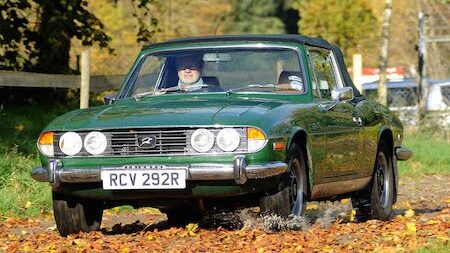For my sins I had the, perhaps dubious, pleasure of working in all three divisions of one of the largest British Leyland dealer groups throughout most of the 70s, meaning that I saw Stags from Sales, Parts and, toughest of all, Service perspectives.
Launched a couple of years before I started my lifelong career in the car industry, I remember as an avid teenage car fan reading excitedly about the arrival of both the Triumph Stag and the Range Rover within just a couple of weeks of each other and both just a shade under £2,000. How history has treated those two cars so differently !
My first exposure to Stags was as a trainee mechanic and often involved the car’s infamous overheating problems. It has been said that some of the Stag’s early woes were related to workshop personnel unaccustomed to such, relatively, advanced technology. In some ways, that’s true. After all, overhead camshafts were still pretty unusual back then as were, to a lesser extent, alloy heads, whilst V8 engines in relatively mainstream British cars were very rare.
However what that accusation misses is that garages were neither charged with, nor had the time or resources to do BL’s troubleshooting work for them.
Accordingly, when a Stag came in with overheating that had led to a warped head, then we would simply exchange the head or heads and send the car back out.
Often it would return some time later with similar issues and in those cases BL would usually authorise the replacement of the engine.
Other than advise to use of the correct coolant, BL provided few, if any, guidelines to overcome the Stag’s overheating issues and relatively few changes were made in the models life to effectively deal with the problems.
Bringing things up to date, it is not altogether unsurprising today to hear of Stag owners with engine numbers that have an ‘ESS’ suffix – that was utilised solely on exchange units.
However, on being ‘promoted’ from the shop floor to reception, I discovered what being at the sharp end really meant.
Stag owners were, understandably, annoyed that one of the most expensive BL cars made was giving them problems, often repeatedly, and BL was represented by just one person – the poor receptionist.
That was one thing within the warranty period, yet a completely different matter once it had run out – then, they had to pay !

As we had had so many difficult situations, I recollect our service manager instructing us that whenever a Stag owner brought in a car with signs of overheating, we should forewarn them that the repair might be in excess of £1000. That wasn’t easy to say however it did take a little of the sting out of the situation upon collection.
However, despite being the largest Rover Triumph dealer in South Wales we did have a not insignificant number of Stag owners who had few problems and who loved their cars. To be fair, and perhaps contrary to common misconception, we didn’t see a vast number of Stags in our workshops, although that may have had more to do with the poor sales history rather than their reliability.
Today, all of the Stag’s former woes can be resolved and the car can be seen for the great car that it always promised to be. If only BL had been able to apply themselves fully to dealing with the problems back then.
As a footnote, even today there are Stag owners who are finding significant quantities of casting sand still left inside their engines – that shouldn’t have been too hard for BL to diagnose back then.
All articles & images are copyright of their creators

